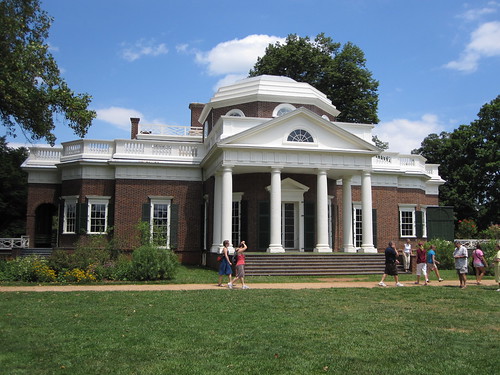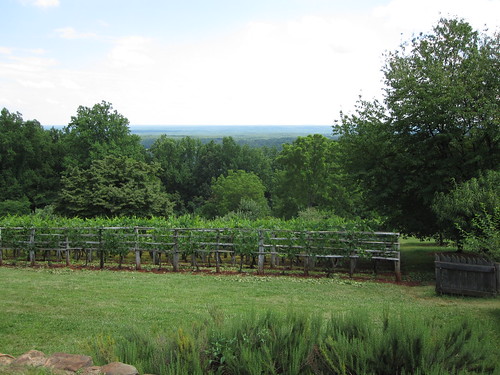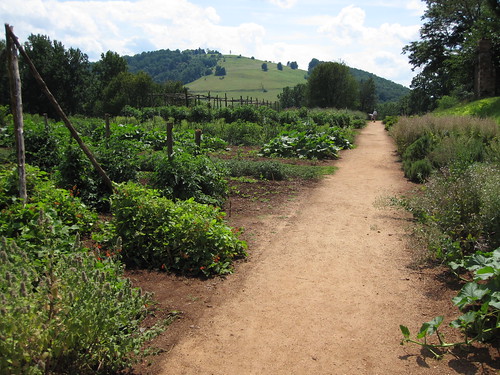“I am as happy no where else and in no other society, and all my wishes end, where I hope my days will end, at Monticello.” –Thomas Jefferson, 1787
Strolling the grounds of one of America’s most famous homesteads, with its tidy green spaces and views of the Blue Ridge Mountains stretching out from either side, one could see why Thomas Jefferson sought always to be here, at Monticello. Monticello, with its book-lined walls, its stretching gardens and its needs, was — for Jefferson — the only place worth being, even during his trips to France as U.S. Minister or his time as president. And honestly, who could blame him?
The day trip to Charlottesville, Virginia, from DC was inspired in part by a graphic essay by Maira Kalman in the New York Times called “Time Wastes too Fast.” Kalman retells her own pilgrimage to Monticello with a quaint and quirky awe at the man, his accomplishments and his life there. “If you want to understand country and its people and what it means to be optimistic and complex and tragic and wrong and courageous, you need to visit his home in Monticello,” she writes. Okay Maira, I’m sold.
Thomas Jefferson was all of these things and many more. While touring, I overheard a man sharing a story: “John F. Kennedy once invited about fifteen nobel prize winners over to his house for dinner. As they were sitting around the dinner table, chatting, Kennedy thanked them for coming. ‘Never,’ he said, ‘has the White House housed and fed so much collective intelligence. Except,’ he continued, ‘when Thomas Jefferson dined alone.'” This was a man who wrote the seminal document in the founding of our country when he was just 31 years of age. He read thousands of books, seemed to have an interest in almost every subject — botany, architecture, philosophy, law, foreign relations, agriculture, astronomy, biology, to name just a few. He kept exhaustive records of the on-goings at Monticello and wrote thousands of letters, many of which still exist today because he made copies with an early copy machine — one of his favorite objects.
It is perhaps all of these things about Jefferson, as well as his importance and moral complexity, that draws great crowds of families to the plantation. Our trip was on a perfect Sunday afternoon and the newly-built, sleek visitors center was packed with people buying tickets, shopping for TJ souvenirs and eating lunch. As a practical note, buying your tickets online is probably a wise thing to do, as tours fill up very quickly and much in advance of their start times. If you’re going to go to Monticello, you might want to ensure you can do it leisurely. It takes two and a half hours to get to the place, barring bad traffic, and once there you’ll need to wait in line for a ticket and get up the mountain from the visitors center either by shuttle bus or by walking.
The walk up the “little mountain” was short — just a quarter mile — and very quiet and beautiful. The pre-tour video about the life of Jefferson and history of Monticello showed b-roll clips of fake Jefferson riding his horse through these woods and I half expected to spy him trodding along south of the trail. Half-way up is the family grave plot, with Jefferson’s tombstone looming epically over the rest — a 10-foot-tall obelisk of stone. Descendants of the Jefferson-Randolph line are still buried there each year.
Up at the house, we lined up for our tour, led by a very enthusiastic and knowledgeable guide. From there we were herded into each successive room of the first floor (the top floor presumably made inaccessible by the fact that Jefferson built a staircase that was just 22-inches wide). The first room, the receiving room is filled with curious wall-hangings which our guide informed us was meant to educate Jefferson’s guests while they waited to be received by him. There were maps of South America, Virginia and the Continental United States, flanked by a few animal’s horns and opposite a spread of Native American artifacts. Adding to his many complexities as a problematic figure, Jefferson was fascinated by Native Americans and their culture.
The tour moved like clockwork, or magic. The guides are trained to the second to move from one room to another in an extremely scheduled but somehow effortless fashion. There was the family sitting room, which could barely hold our tour group, Jefferson’s library/study/bedroom. Jefferson was a fan of the alcove bed, he discovered it in Paris and then came back to the states and cut a hole in a wall for his own bed. He was also the first person to put skylights in their house in the U.S. Several of his rooms are lined with portraits of friends and men who inspired him, especially his buddy James Madison and the Marquis de Lafayette. I had to laugh — how weird would it be if you came to visit your friend’s house and they had a bust of your face hanging out in their living room? My friend pointed out that this was approximately the same as hanging photographs of friends, but even then, how rarely do we hang a single photo of one single person. Of all the curious things about Monticello and the time, however, this is a bit nitpicky of me.
I had braced myself for a painful mismanaging or deft evasion of the subject of the Hemings family and the other 130 plus slaves Jefferson — guiding light of “freedom” — held over his lifetime. However, the Monticello organization did what I thought was a decent job of taking every opportunity to point out and shed light upon the hypocritical mindset of Jefferson, defender of equality and lifetime slave owner. Despite his convictions and his genetic ties to the Hemings family, he only ever gave freedom to a handful of slaves and his debt ensured that the rest of the enslaved people at Monticello would be sold after his death. Inspired by this journey, I’m now taking this time to read the much touted book “The Hemingses of Monticello,” an account of the perhaps best-known and well-recorded slave lives. I’m sure there is criticism to be found, but time contraints (Time wastes too fast!) kept us from spending another couple hours touring the slave quarters. On our way out of the site, we did pause at the African-American burial site which is for all intents and purposes simply a piece of forest with a sign in the middle of the parking lot.
Outside we quickly shifted over to the Garden Tour. Our lovely, tiny guide Linda led us around the grounds, pointing out trees and facts about them along the way in a way that was wonderfully disunified. Jefferson brought plants back from wherever he went and attempted to grow them by trial and error, marking each plant with one of those garden tongue depressors. He originally had the garden planted on the hillside, then later carved out a flat terrace for easier access. Today there is every type of vegetable growing, there is a vineyard, a rash of fig trees and an orchard. After leaving Linda, we wandered down to be alone among the peach and apple trees. Probably because of the slope of the hill, few tourists ventured down off the garden. While we were sauntering around, stealing Jefferson’s plums, we looked back up the hill to another visitors building, only to see a woman being proposed to on the balcony squeezed in between the Coke machine and the scenic panorama. We cheered. Monticello, place of romance! Romantic, yes, in some sense — in another sense, it is not so much romance as a sort of historical mystery — a desire to grasp at understanding a man and a place and a time that, even after ten trips to Monticello, could not be satisfied.






I loved this article and hope to get an opportunity to visit this historical spot myself at sometime in the future! Thank you for sharing the details of your sunday afternoon visit with us.
I love going down to Monticello and the surrounding areas for the weekend. I’m also going to attempt to hit up his other house, Poplar Forest, this fall.
Stay in Charlottesville at the South Street Inn and go to brunch either at Bizou or up on the Corner at Three.
Great write up!
Great article. There is a Professor that just spoke on the subject of civic virtue in DC through the BBC Reith lectures at George Washington University. He relies heavily on Jefferson’s agrarian argument in building civic virtue. They are all audio. I certainly enjoyed them.
http://www.bbc.co.uk/programmes/b00729d9